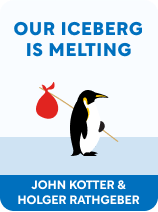

This article is an excerpt from the Shortform book guide to "Our Iceberg Is Melting" by John P. Kotter and Holger Rathgeber. Shortform has the world's best summaries and analyses of books you should be reading.
Like this article? Sign up for a free trial here .
Is the fable Our Iceberg Is Melting worth reading? How can this book help drive change in your company?
John Kotter and Holger Rathgeber’s fable is about a colony of penguins who must make quick and drastic changes in order to save their colony. This fable is meant to help companies during the change process and was a New York Times bestseller.
Continue below for our Our Iceberg Is Melting review, including the book’s background and critical reception.
Our Iceberg Is Melting by John Kotter
Our Iceberg Is Melting is a fable about a colony of penguins who realize that their home might be destroyed soon, and that they need to move the entire colony to a new iceberg. However, despite the looming threat, making such a big change isn’t easy.
This book by Dr. John Kotter and Holger Rathgeber will teach you, through the penguin fable, the necessary steps in making major changes to your company or your personal life.
Here is our Our Iceberg Is Melting review, including its context and its critical reception.
About the Authors
Dr. John Kotter is a professor emeritus at the Harvard Business School and the founder of the management consulting firm Kotter International. He’s widely regarded as one of the world’s top authorities on effective leadership and driving change.
Holger Rathgeber is an affiliate of Kotter International. He’s spent over 15 years working as a facilitator, helping companies to develop and implement effective business strategies. Rathgeber has an economics degree from the University of Stuttgart-Hohenheim.
Connect with John Kotter:
Connect with Holger Rathgeber:
The Book’s Publication
Publisher: Penguin Random House
Imprint: Portfolio / Penguin
The original edition of Our Iceberg Is Melting was published in 2006. The 10th anniversary edition—published in 2016—adds new illustrations, an updated afterword, and a Q&A from Kotter and Rathgeber. (This guide references the 2016 edition.)
Historical Context
The original edition of Our Iceberg Is Melting came out in 2006, around the time of the U.S. housing market crash and just before the Great Recession. It was a time of major changes in the economic world, so the lessons in this fable were especially important.
Intellectual Context
Our Iceberg Is Melting is a spiritual successor to Who Moved My Cheese, another animal-centric fable about making necessary changes. However, while Who Moved My Cheese? focused on making changes at the personal level (a mouse finding a new food source), Our Iceberg Is Melting expands those ideas to the organizational level (moving an entire penguin colony to a new location).
| Who Moved My Cheese?:7 steps for personal change | Our Iceberg Is Melting:8 steps for organizational change |
| Step 1: Be prepared for change | Step 1: Create urgency |
| Step 2: Let go of the past | Step 2: Assemble a team |
| Step 3: Adapt—be open to new things | Step 3: Create a vision |
| Step 4: Imagine success | Step 4: Enlist volunteers |
| Step 5: Handle your fears | Step 5: Remove barriers |
| Step 6: Learn to enjoy change | Step 6: Win small victories |
| Step 7: Be prepared for continuous change | Step 7: Accelerate change |
| Step 8: Cement the changes |
There are distinct parallels between the two processes:
- Step 1 of personal change is to be ready for it, while step 1 of organizational change is to create urgency—thereby making sure that your colleagues are ready for change.
- Step 4 of personal change and step 3 of organizational change are both about imagining the future; what’s your goal, and what do you need to do in order to reach it?
- Step 5 in both processes is to eliminate obstacles. This step is explicitly stated in the organizational change process; meanwhile, when it comes to personal change, the biggest obstacle you’re facing is probably your own fear.
- Step 6 of both processes is to appreciate and celebrate what you’ve already accomplished, even if you haven’t achieved your main goal yet.
- Step 7 of both processes is to be ready to make more changes, and strive for continuous improvement.
- The organizational change process goes a step further by advising that you take steps to make the changes permanent within your organization—this step may not be necessary in personal change, because there won’t be other people trying to undo what you’ve accomplished.
Fables are generally seen as learning tools for children (Aesop’s Fables are the most famous examples). Fables for adults, including business fables like Who Moved My Cheese? and Our Iceberg Is Melting, are quite recent by comparison. However, increasing numbers of people are finding that stories are more engaging and memorable—even for adults—than dry lectures or purely informational books.
The Book’s Impact
Our Iceberg Is Melting has become a go-to book for organizations that are looking to make major changes. Amazon reviews, as well as the quotes at the beginning of the book itself, show that organizations ranging from local church groups to major multinational corporations have used the lessons in Our Iceberg Is Melting to drive positive internal change.
The publisher’s page for Our Iceberg Is Melting states that it has “…changed millions of lives in organizations around the world.”
Critical Reception
Our Iceberg Is Melting is a New York Times bestseller, and high-ranking executives from many different corporations have praised the book for its simple, clear approach to the difficult topic of driving change.
For example, Tom Curley, President and CEO of the Associated Press, said that they’d “…moved quickly on several fronts,” thanks to the lessons in this book. Richard Kosinski, a category development officer at Yahoo, said that it’s a “must-read” for anyone in charge of a major change at a company.
However, some reviews on Amazon, Goodreads, and other sites argue that the book’s approach was too simple to be useful—that it glosses over all the actual work of driving change with a cute story. Others felt that the authors were talking down to them by writing Our Iceberg Is Melting in the style of a children’s book.
Commentary on the Book’s Approach
The information in Our Iceberg Is Melting is presented as a fable, to show why each step of driving change is important, and how each step plays out in practice. This approach is intended to be more engaging and more helpful than a simple list of steps to follow.
Commentary on the Book’s Organization
Our Iceberg Is Melting is well organized—each action the characters take logically leads to the next, and you can see how those actions drive the necessary changes to save the penguin colony. The authors also include a simple list of their eight steps for change at the end of the book, which is a helpful reference after you’ve read the penguin fable.
Since each of Kotter’s eight steps relies upon the steps before it, and the penguin story follows those eight steps, this is the best way to organize the information that Kotter and Rathgeber present within this book.

———End of Preview———
Like what you just read? Read the rest of the world's best book summary and analysis of John P. Kotter and Holger Rathgeber's "Our Iceberg Is Melting" at Shortform .
Here's what you'll find in our full Our Iceberg Is Melting summary :
- A fable about the necessary steps in making major changes
- Dr. John Kotter’s eight-step process for change
- Why your job isn’t done just because you accomplished your goal






